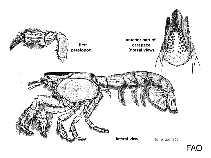Upogebia capensis (Krauss, 1843)
Cape mud shrimpWarning: DOMDocument::load(): SSL operation failed with code 1. OpenSSL Error messages: error:140770FC:SSL routines:SSL23_GET_SERVER_HELLO:unknown protocol in C:\Apache24\htdocs\includes\SpeciesSummary.lib.php on line 1236
Warning: DOMDocument::load(): Failed to enable crypto in C:\Apache24\htdocs\includes\SpeciesSummary.lib.php on line 1236
Warning: DOMDocument::load(https://sealifebase.nrm.se/webservice/AquaMaps/getAMap.php?genus=Upogebia&species=capensis): failed to open stream: operation failed in C:\Apache24\htdocs\includes\SpeciesSummary.lib.php on line 1236
Warning: DOMDocument::load(): I/O warning : failed to load external entity "https://sealifebase.nrm.se/webservice/AquaMaps/getAMap.php?genus=Upogebia&species=capensis" in C:\Apache24\htdocs\includes\SpeciesSummary.lib.php on line 1236
Upload your photos
Google image | No image available for this species;
drawing shows typical species in Upogebiidae.
Google image | No image available for this species;
drawing shows typical species in Upogebiidae.
Classification / Names Common names | Synonyms | CoL | ITIS | WoRMS
| Decapoda | Upogebiidae
Environment: milieu / climate zone / depth range / distribution range Ecología
. Subtropical; 26°S - 37°S, 16°E - 35°E (Ref. 4)
Distribución Países | Áreas FAO | Ecosistemas | Ocurrencias, apariciones | Introducciones
Southeast Atlantic and Western Indian Ocean: South Africa and Mozambique.
Length at first maturity / Tamaño / Peso / Age
Maturity: Lm ? range ? - ? cmCommon length : 1.6 cm TL macho / no sexado; (Ref. 4)
Short description Morfología
Rostrum ending in three teeth; the lateral teeth are placed at the end of a ridge that is separated from the central part of the dorsal surface of the rostrum by a deep groove. On the central part itself a very shallow median groove is present. There are no ventral teeth on the rostrum. The anterolateral border of the carapace with a single spine behind the eye. First pereiopods subchelate. Dactylus of adult male with a longitudinal groove on either lateral surface, and without a tooth on the cutting edge. Palm with 2 dorsal denticulate carinae. Merus without an anterodorsal spine. Coxae of first three pereiopods without spines (Ref. 4).
It has lengths of 1.5 to 1.6 cm, total body length; 2.7 to 6.5 cm, ovigerous females (Ref. 4). It burrows in sandy mud of estuaries form mid-tide to LWS [= Low water spring tide]. It is a detritus feeder (Ref. 4).
Life cycle and mating behavior Madurez | Reproducción | Puesta | Huevos | Fecundidad | Larva
Members of the order Decapoda are mostly gonochoric. Mating behavior: Precopulatory courtship ritual is common (through olfactory and tactile cues); usually indirect sperm transfer.
Main reference
Referencias | Coordinador | Colaboradores
Holthuis, L.B. 1991. (Ref. 4)
IUCN Red List Status (Ref. 130435)
CITES status (Ref. 108899)
Not Evaluated
CMS (Ref. 116361)
Not Evaluated
Threat to humans
Human uses
Carnada: usually
| FishSource |
Herramientas
Más información
Países
Áreas FAO
Ecosistemas
Ocurrencias, apariciones
Introducciones
Stocks
Ecología
Dieta
componentes alimenticios
Áreas FAO
Ecosistemas
Ocurrencias, apariciones
Introducciones
Stocks
Ecología
Dieta
componentes alimenticios
Fuentes de Internet
BHL | BOLD Systems | CISTI | DiscoverLife | FAO(Publication : search) | Fishipedia | GenBank (genome, nucleotide) | GloBI | Gomexsi | Google Books | Google Scholar | Google | PubMed | Árbol de la vida | Wikipedia (Go, búsqueda) | Expediente Zoológico
Estimates based on models
Price category
(Ref. 80766):
Unknown.



